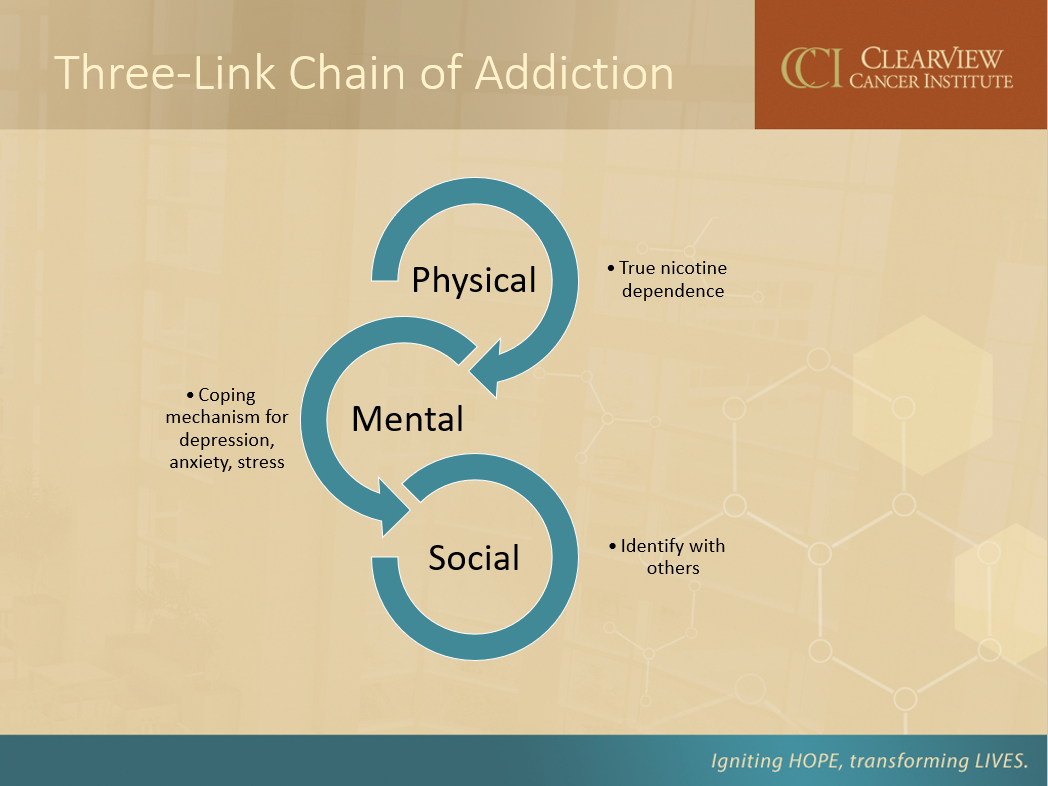If you’re a smoker, we know it’s not easy to quit. Addiction is defined as the “mental and/or emotional dependence on a substance”. Regarding tobacco usage, nicotine is the substance that creates this addiction. Nicotine (and other chemicals in tobacco) are easily absorbed into the blood through the lungs. It acts on the brain and nervous system to release dopamine and norepinephrine which gives the user a pleasant feeling and increases alertness and concentration. The release wears off a few minutes later and withdrawal symptoms can begin within 1-2 hours creating the desire to continue the behavior.
“Addiction is multi-fold. Understanding this is the best way to overcome addiction,” said Cyndi Lemery, a nurse of 18 years, she now serves as the Lung Screening program coordinator at Clearview Cancer Institute. “Developing a ‘quit plan’ increases a smoker’s chances of success.”

The Physical Effect
Biologically, people using tobacco have a physical reaction to nicotine. This involves the reduction of anxiety and stabilized mood. Nicotine relaxes smooth muscles, suppresses appetite, and increases blood pressure. It takes less than 10 seconds for nicotine to cross the blood brain barrier resulting in the effects we just discussed. In a nutshell, people get hooked on how nicotine affects their mind and body.
The Mental Effect
Psychologically, use of tobacco products become a habit. This habit is usually related to environmental cues such as your morning coffee, driving, after meals, or smoke breaks from work. Additionally, tobacco is used to cope with underlying conditions such as anxiety, stress, and depression. People become hooked on the feeling of smoking.
The Social Effect
Socially tobacco use may be a part of identifying with a group, or a part of social/cultural practices. People become addicted to the connections that smoking helps you make with other people. Often times you feel more at ease, or like you belong, with a cigarette in your hand. And surrounded by people that also smoke.
Triggers
A trigger is defined as a situation or event that sets off the urge to use tobacco.
Most triggers fall into one of these four categories:
- Emotional
Feeling intense emotions, either good or bad, can make a person want to smoke. - Pattern
Pattern triggers are tied to things you do on a regular basis such as driving, talking on the phone, or watching TV. - Social
Social triggers are tied to being around other people. You may be triggered when you see others smoking or being with fellow smokers. Be open and honest with people in your life. Let them know your goal and ask them for support. Avoid places where you know these triggers exist. Again, you won’t manage all your triggers overnight, but with small changes over time, you will find that the triggers happen less and less - Withdrawal
When it comes to withdrawal triggers, distract yourself. Understand that when your body craves nicotine and you don’t give in to that craving, you will naturally release the chemicals. This is encouraging! Find something to do for 5-10 and the desire will pass! And remember that positive thinking has so much power! Remind yourself that you’re doing great, and you CAN achieve this goal
“Smokers can identify triggers by thinking about their day and what reminds them to reach for that cigarette or device,” said Lemery. “You must believe that quitting is possible. Leave behind any previous quitting attempts. Find your confidence and know that you can succeed,” said Lemery. “The long term benefits of quitting far outweigh the short term discomforts. You must bring together what you know in your head and heart with what you feel in your gut. When you make that connection, your confidence will grow as will your desire to stop smoking.”
Form a Quit Plan
- Choose a day. Maybe your desire is to stop smoking before a big life event, like the birth of a child or grandchild. Maybe you want to quit smoking because you want to start a family. Whatever your reason for quitting, pick a day and mark it on your calendar.
- Figure out how much money you’re spending on your tobacco products. Then set a goal or a reward for yourself. For example: By saving “X” I can now travel more, pay off debt, save, etc.
- Identify your why. What motivates you to stop smoking? Write this down where you can see it often and be reminded daily.
- Know your triggers. Identify those triggers and create a plan for them. Whether it’s avoiding the situation or choosing an alternative activity. Don’t be caught off guard. Really spend a lot of time on this step. Find a friend to help you. Someone you can call when those triggers happen.
- Set yourself up for success. This could mean finding a group or class. Talk to your friends and family. Develop a plan for when cravings hit.
